PUBH6001: Health Policy and Advocacy: Policy Brief on Tobacco Control
VerifiedAdded on 2023/06/11
|7
|1888
|57
Report
AI Summary
This report addresses the growing concern of tobacco consumption in Australia and explores health policies designed to mitigate its harmful effects. It highlights the initiatives by the Council of Australian Governments (COAG) to reduce tobacco use through education, advertising restrictions, and nicotine replacement therapies. The report identifies issues in policy implementation, such as the lack of strict laws and penalties, and proposes alternative frameworks like public awareness campaigns and increased taxation. Key stakeholders involved in tobacco consumption, primarily individuals aged 15-45, particularly those facing stress and socioeconomic challenges, are discussed. Recommendations include public health approaches, school-based education, risk assessments, and mass media programs to raise awareness and enforce restrictions. The report concludes by emphasizing the importance of continued efforts to reduce tobacco consumption and promote healthier lifestyles in Australia. Desklib provides access to similar solved assignments and past papers for students.
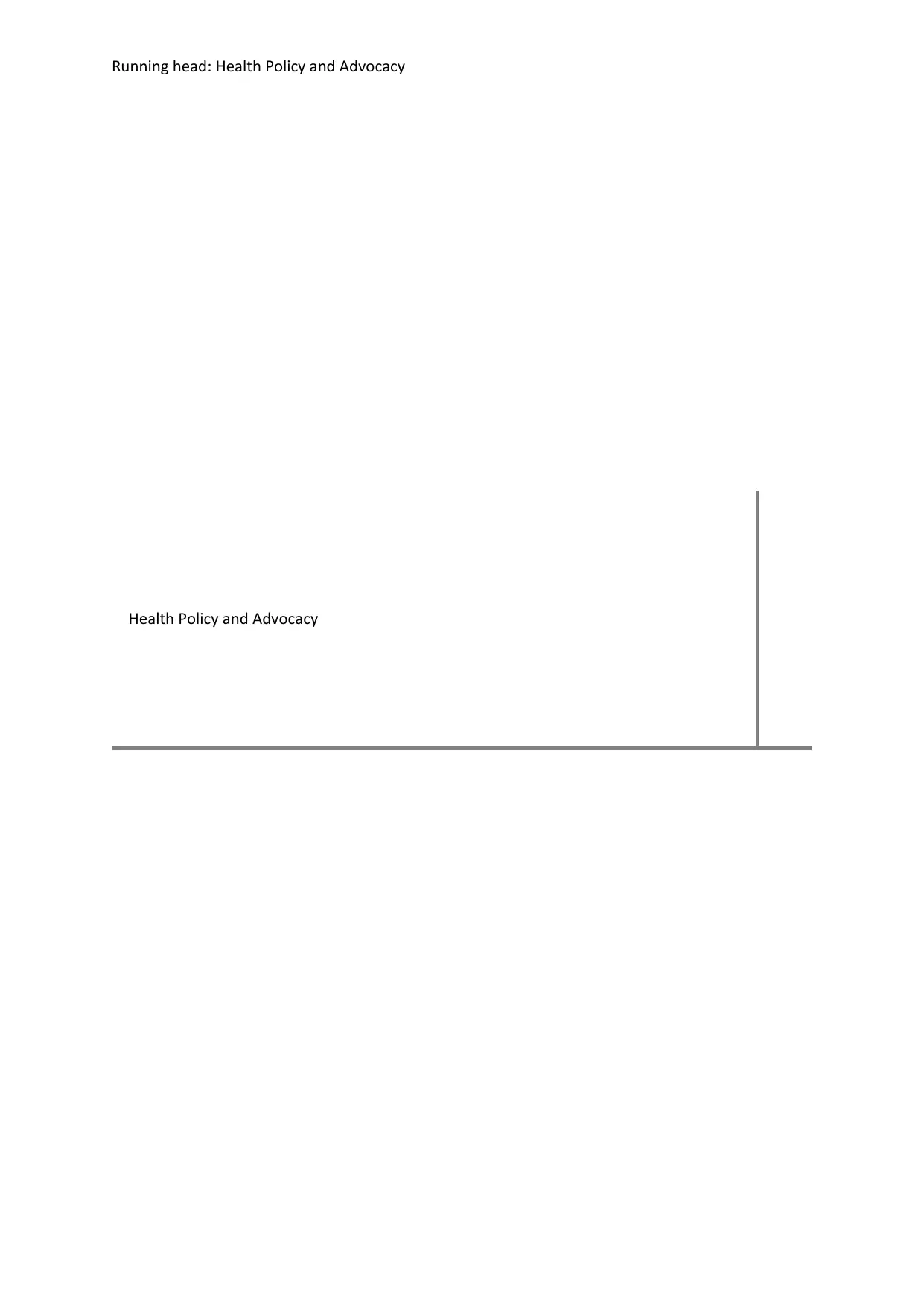
Running head: Health Policy and Advocacy
Health Policy and Advocacy
Health Policy and Advocacy
Paraphrase This Document
Need a fresh take? Get an instant paraphrase of this document with our AI Paraphraser
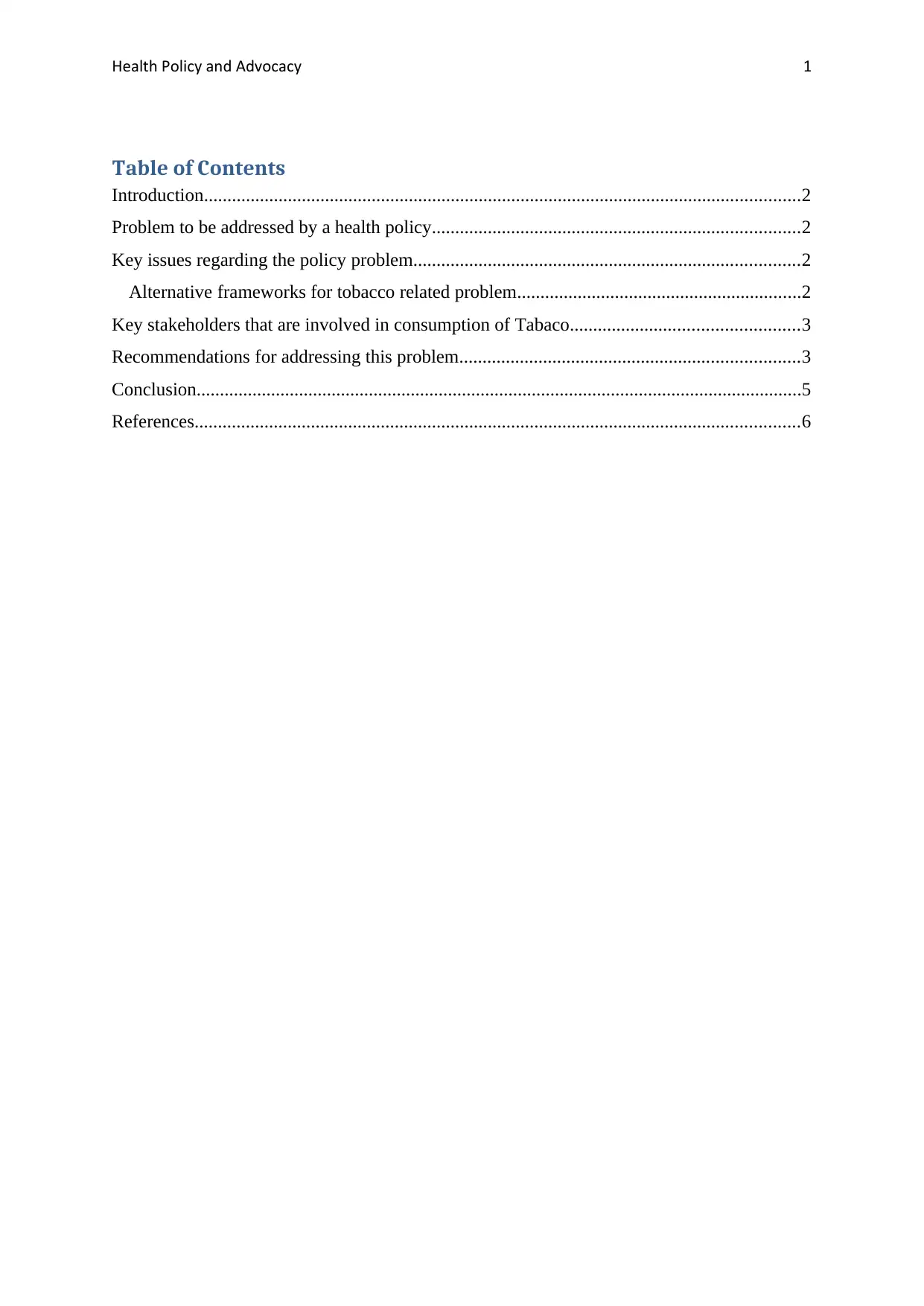
Health Policy and Advocacy 1
Table of Contents
Introduction................................................................................................................................2
Problem to be addressed by a health policy...............................................................................2
Key issues regarding the policy problem...................................................................................2
Alternative frameworks for tobacco related problem.............................................................2
Key stakeholders that are involved in consumption of Tabaco.................................................3
Recommendations for addressing this problem.........................................................................3
Conclusion..................................................................................................................................5
References..................................................................................................................................6
Table of Contents
Introduction................................................................................................................................2
Problem to be addressed by a health policy...............................................................................2
Key issues regarding the policy problem...................................................................................2
Alternative frameworks for tobacco related problem.............................................................2
Key stakeholders that are involved in consumption of Tabaco.................................................3
Recommendations for addressing this problem.........................................................................3
Conclusion..................................................................................................................................5
References..................................................................................................................................6
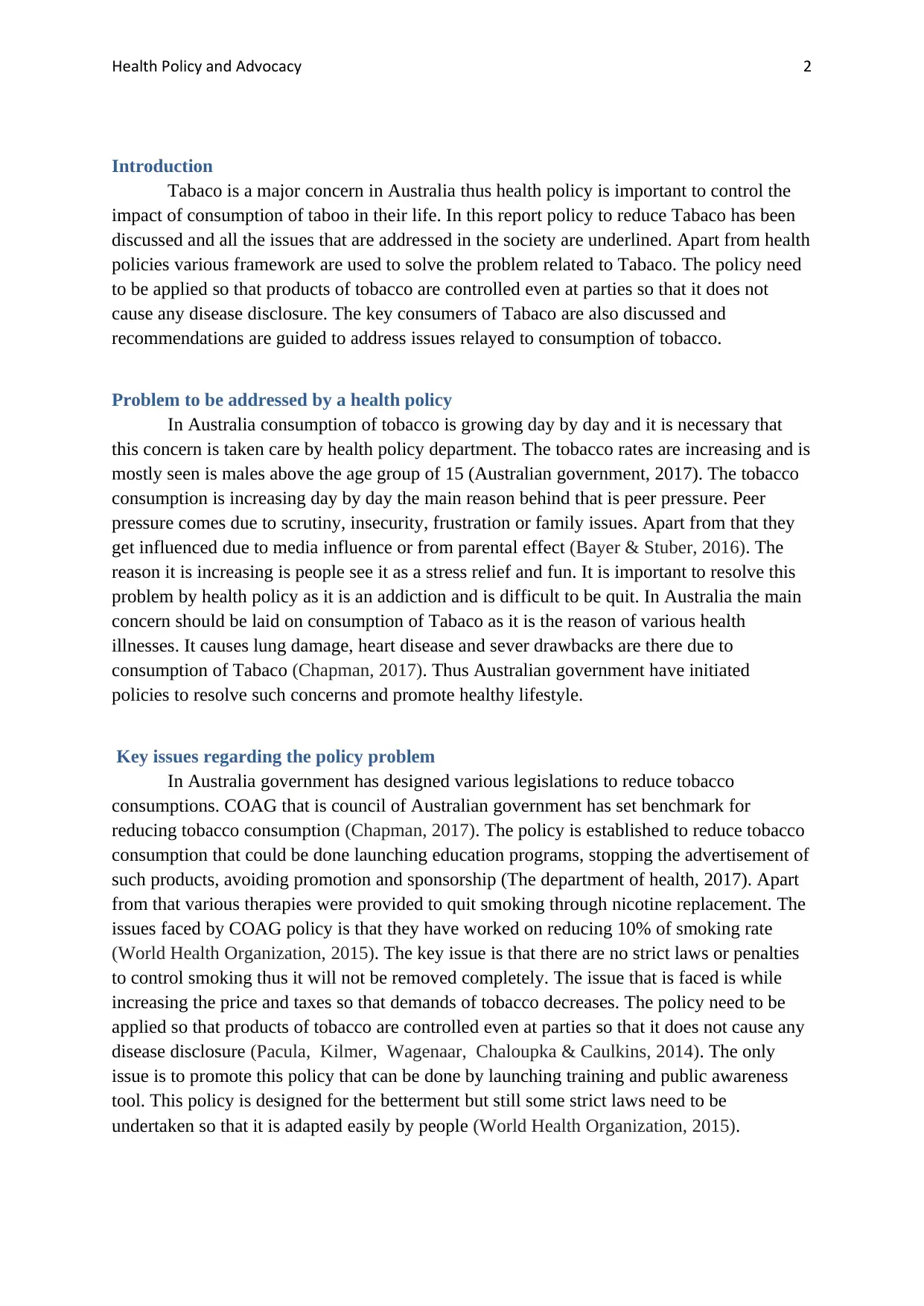
Health Policy and Advocacy 2
Introduction
Tabaco is a major concern in Australia thus health policy is important to control the
impact of consumption of taboo in their life. In this report policy to reduce Tabaco has been
discussed and all the issues that are addressed in the society are underlined. Apart from health
policies various framework are used to solve the problem related to Tabaco. The policy need
to be applied so that products of tobacco are controlled even at parties so that it does not
cause any disease disclosure. The key consumers of Tabaco are also discussed and
recommendations are guided to address issues relayed to consumption of tobacco.
Problem to be addressed by a health policy
In Australia consumption of tobacco is growing day by day and it is necessary that
this concern is taken care by health policy department. The tobacco rates are increasing and is
mostly seen is males above the age group of 15 (Australian government, 2017). The tobacco
consumption is increasing day by day the main reason behind that is peer pressure. Peer
pressure comes due to scrutiny, insecurity, frustration or family issues. Apart from that they
get influenced due to media influence or from parental effect (Bayer & Stuber, 2016). The
reason it is increasing is people see it as a stress relief and fun. It is important to resolve this
problem by health policy as it is an addiction and is difficult to be quit. In Australia the main
concern should be laid on consumption of Tabaco as it is the reason of various health
illnesses. It causes lung damage, heart disease and sever drawbacks are there due to
consumption of Tabaco (Chapman, 2017). Thus Australian government have initiated
policies to resolve such concerns and promote healthy lifestyle.
Key issues regarding the policy problem
In Australia government has designed various legislations to reduce tobacco
consumptions. COAG that is council of Australian government has set benchmark for
reducing tobacco consumption (Chapman, 2017). The policy is established to reduce tobacco
consumption that could be done launching education programs, stopping the advertisement of
such products, avoiding promotion and sponsorship (The department of health, 2017). Apart
from that various therapies were provided to quit smoking through nicotine replacement. The
issues faced by COAG policy is that they have worked on reducing 10% of smoking rate
(World Health Organization, 2015). The key issue is that there are no strict laws or penalties
to control smoking thus it will not be removed completely. The issue that is faced is while
increasing the price and taxes so that demands of tobacco decreases. The policy need to be
applied so that products of tobacco are controlled even at parties so that it does not cause any
disease disclosure (Pacula, Kilmer, Wagenaar, Chaloupka & Caulkins, 2014). The only
issue is to promote this policy that can be done by launching training and public awareness
tool. This policy is designed for the betterment but still some strict laws need to be
undertaken so that it is adapted easily by people (World Health Organization, 2015).
Introduction
Tabaco is a major concern in Australia thus health policy is important to control the
impact of consumption of taboo in their life. In this report policy to reduce Tabaco has been
discussed and all the issues that are addressed in the society are underlined. Apart from health
policies various framework are used to solve the problem related to Tabaco. The policy need
to be applied so that products of tobacco are controlled even at parties so that it does not
cause any disease disclosure. The key consumers of Tabaco are also discussed and
recommendations are guided to address issues relayed to consumption of tobacco.
Problem to be addressed by a health policy
In Australia consumption of tobacco is growing day by day and it is necessary that
this concern is taken care by health policy department. The tobacco rates are increasing and is
mostly seen is males above the age group of 15 (Australian government, 2017). The tobacco
consumption is increasing day by day the main reason behind that is peer pressure. Peer
pressure comes due to scrutiny, insecurity, frustration or family issues. Apart from that they
get influenced due to media influence or from parental effect (Bayer & Stuber, 2016). The
reason it is increasing is people see it as a stress relief and fun. It is important to resolve this
problem by health policy as it is an addiction and is difficult to be quit. In Australia the main
concern should be laid on consumption of Tabaco as it is the reason of various health
illnesses. It causes lung damage, heart disease and sever drawbacks are there due to
consumption of Tabaco (Chapman, 2017). Thus Australian government have initiated
policies to resolve such concerns and promote healthy lifestyle.
Key issues regarding the policy problem
In Australia government has designed various legislations to reduce tobacco
consumptions. COAG that is council of Australian government has set benchmark for
reducing tobacco consumption (Chapman, 2017). The policy is established to reduce tobacco
consumption that could be done launching education programs, stopping the advertisement of
such products, avoiding promotion and sponsorship (The department of health, 2017). Apart
from that various therapies were provided to quit smoking through nicotine replacement. The
issues faced by COAG policy is that they have worked on reducing 10% of smoking rate
(World Health Organization, 2015). The key issue is that there are no strict laws or penalties
to control smoking thus it will not be removed completely. The issue that is faced is while
increasing the price and taxes so that demands of tobacco decreases. The policy need to be
applied so that products of tobacco are controlled even at parties so that it does not cause any
disease disclosure (Pacula, Kilmer, Wagenaar, Chaloupka & Caulkins, 2014). The only
issue is to promote this policy that can be done by launching training and public awareness
tool. This policy is designed for the betterment but still some strict laws need to be
undertaken so that it is adapted easily by people (World Health Organization, 2015).
⊘ This is a preview!⊘
Do you want full access?
Subscribe today to unlock all pages.

Trusted by 1+ million students worldwide
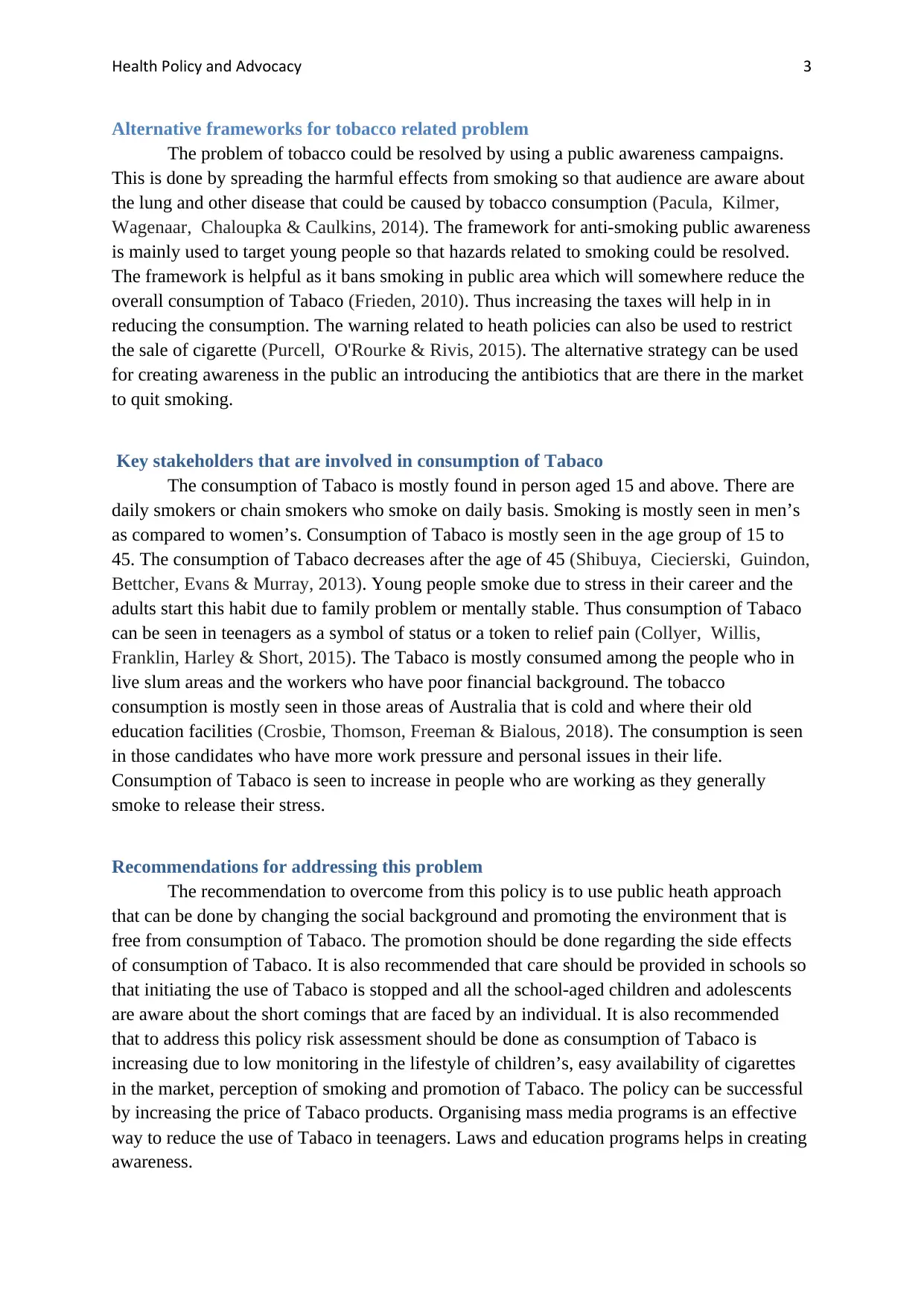
Health Policy and Advocacy 3
Alternative frameworks for tobacco related problem
The problem of tobacco could be resolved by using a public awareness campaigns.
This is done by spreading the harmful effects from smoking so that audience are aware about
the lung and other disease that could be caused by tobacco consumption (Pacula, Kilmer,
Wagenaar, Chaloupka & Caulkins, 2014). The framework for anti-smoking public awareness
is mainly used to target young people so that hazards related to smoking could be resolved.
The framework is helpful as it bans smoking in public area which will somewhere reduce the
overall consumption of Tabaco (Frieden, 2010). Thus increasing the taxes will help in in
reducing the consumption. The warning related to heath policies can also be used to restrict
the sale of cigarette (Purcell, O'Rourke & Rivis, 2015). The alternative strategy can be used
for creating awareness in the public an introducing the antibiotics that are there in the market
to quit smoking.
Key stakeholders that are involved in consumption of Tabaco
The consumption of Tabaco is mostly found in person aged 15 and above. There are
daily smokers or chain smokers who smoke on daily basis. Smoking is mostly seen in men’s
as compared to women’s. Consumption of Tabaco is mostly seen in the age group of 15 to
45. The consumption of Tabaco decreases after the age of 45 (Shibuya, Ciecierski, Guindon,
Bettcher, Evans & Murray, 2013). Young people smoke due to stress in their career and the
adults start this habit due to family problem or mentally stable. Thus consumption of Tabaco
can be seen in teenagers as a symbol of status or a token to relief pain (Collyer, Willis,
Franklin, Harley & Short, 2015). The Tabaco is mostly consumed among the people who in
live slum areas and the workers who have poor financial background. The tobacco
consumption is mostly seen in those areas of Australia that is cold and where their old
education facilities (Crosbie, Thomson, Freeman & Bialous, 2018). The consumption is seen
in those candidates who have more work pressure and personal issues in their life.
Consumption of Tabaco is seen to increase in people who are working as they generally
smoke to release their stress.
Recommendations for addressing this problem
The recommendation to overcome from this policy is to use public heath approach
that can be done by changing the social background and promoting the environment that is
free from consumption of Tabaco. The promotion should be done regarding the side effects
of consumption of Tabaco. It is also recommended that care should be provided in schools so
that initiating the use of Tabaco is stopped and all the school-aged children and adolescents
are aware about the short comings that are faced by an individual. It is also recommended
that to address this policy risk assessment should be done as consumption of Tabaco is
increasing due to low monitoring in the lifestyle of children’s, easy availability of cigarettes
in the market, perception of smoking and promotion of Tabaco. The policy can be successful
by increasing the price of Tabaco products. Organising mass media programs is an effective
way to reduce the use of Tabaco in teenagers. Laws and education programs helps in creating
awareness.
Alternative frameworks for tobacco related problem
The problem of tobacco could be resolved by using a public awareness campaigns.
This is done by spreading the harmful effects from smoking so that audience are aware about
the lung and other disease that could be caused by tobacco consumption (Pacula, Kilmer,
Wagenaar, Chaloupka & Caulkins, 2014). The framework for anti-smoking public awareness
is mainly used to target young people so that hazards related to smoking could be resolved.
The framework is helpful as it bans smoking in public area which will somewhere reduce the
overall consumption of Tabaco (Frieden, 2010). Thus increasing the taxes will help in in
reducing the consumption. The warning related to heath policies can also be used to restrict
the sale of cigarette (Purcell, O'Rourke & Rivis, 2015). The alternative strategy can be used
for creating awareness in the public an introducing the antibiotics that are there in the market
to quit smoking.
Key stakeholders that are involved in consumption of Tabaco
The consumption of Tabaco is mostly found in person aged 15 and above. There are
daily smokers or chain smokers who smoke on daily basis. Smoking is mostly seen in men’s
as compared to women’s. Consumption of Tabaco is mostly seen in the age group of 15 to
45. The consumption of Tabaco decreases after the age of 45 (Shibuya, Ciecierski, Guindon,
Bettcher, Evans & Murray, 2013). Young people smoke due to stress in their career and the
adults start this habit due to family problem or mentally stable. Thus consumption of Tabaco
can be seen in teenagers as a symbol of status or a token to relief pain (Collyer, Willis,
Franklin, Harley & Short, 2015). The Tabaco is mostly consumed among the people who in
live slum areas and the workers who have poor financial background. The tobacco
consumption is mostly seen in those areas of Australia that is cold and where their old
education facilities (Crosbie, Thomson, Freeman & Bialous, 2018). The consumption is seen
in those candidates who have more work pressure and personal issues in their life.
Consumption of Tabaco is seen to increase in people who are working as they generally
smoke to release their stress.
Recommendations for addressing this problem
The recommendation to overcome from this policy is to use public heath approach
that can be done by changing the social background and promoting the environment that is
free from consumption of Tabaco. The promotion should be done regarding the side effects
of consumption of Tabaco. It is also recommended that care should be provided in schools so
that initiating the use of Tabaco is stopped and all the school-aged children and adolescents
are aware about the short comings that are faced by an individual. It is also recommended
that to address this policy risk assessment should be done as consumption of Tabaco is
increasing due to low monitoring in the lifestyle of children’s, easy availability of cigarettes
in the market, perception of smoking and promotion of Tabaco. The policy can be successful
by increasing the price of Tabaco products. Organising mass media programs is an effective
way to reduce the use of Tabaco in teenagers. Laws and education programs helps in creating
awareness.
Paraphrase This Document
Need a fresh take? Get an instant paraphrase of this document with our AI Paraphraser
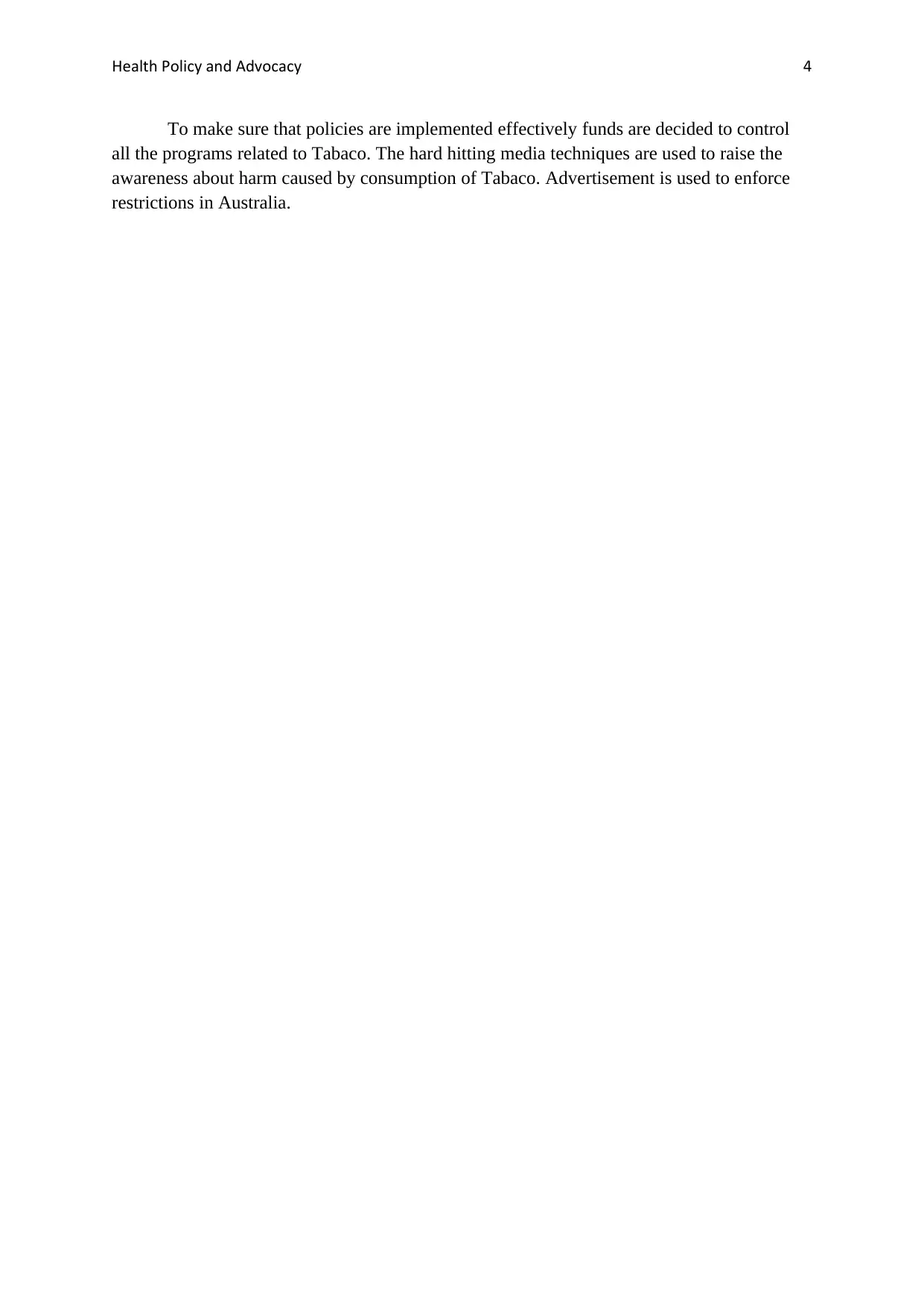
Health Policy and Advocacy 4
To make sure that policies are implemented effectively funds are decided to control
all the programs related to Tabaco. The hard hitting media techniques are used to raise the
awareness about harm caused by consumption of Tabaco. Advertisement is used to enforce
restrictions in Australia.
To make sure that policies are implemented effectively funds are decided to control
all the programs related to Tabaco. The hard hitting media techniques are used to raise the
awareness about harm caused by consumption of Tabaco. Advertisement is used to enforce
restrictions in Australia.
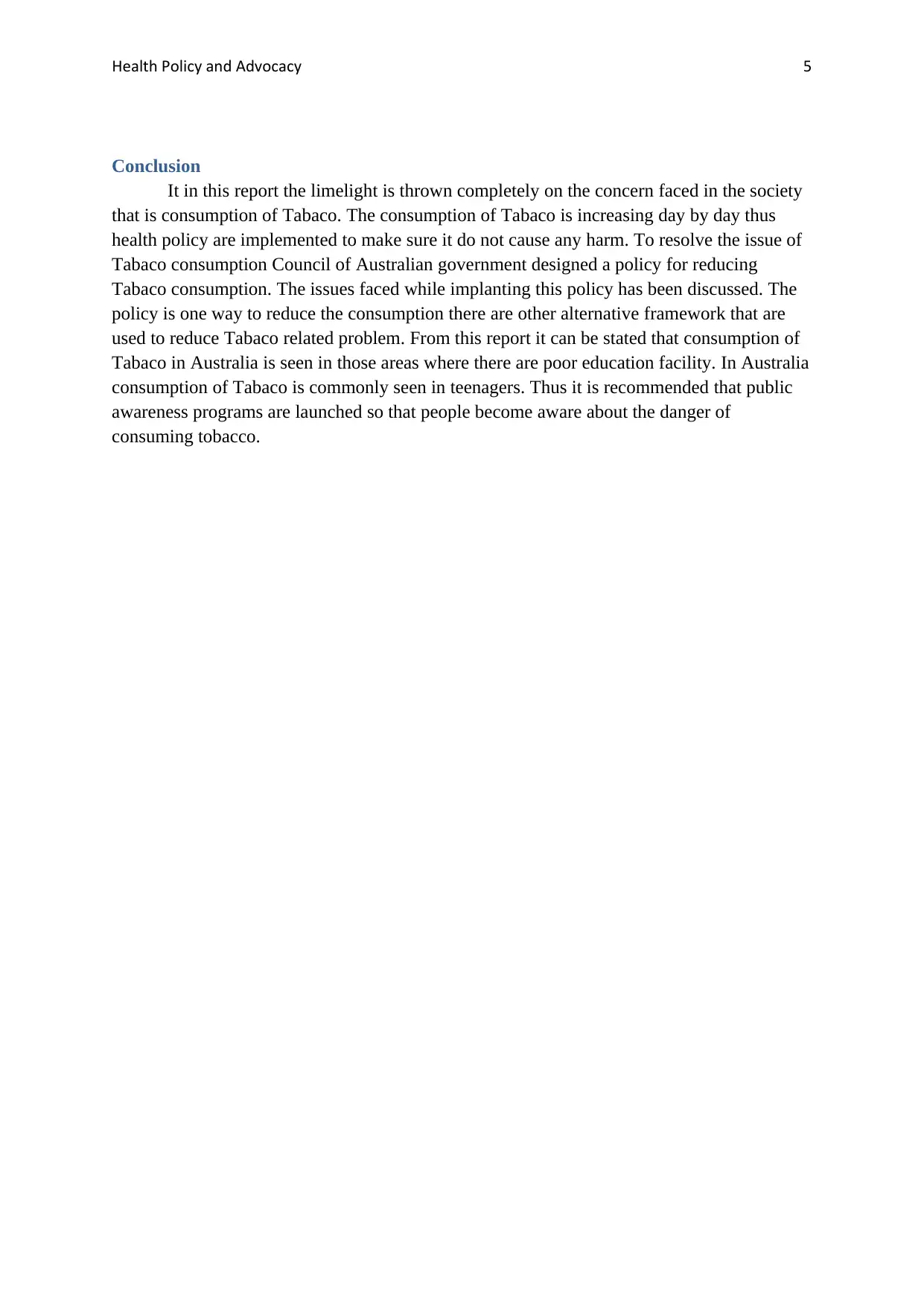
Health Policy and Advocacy 5
Conclusion
It in this report the limelight is thrown completely on the concern faced in the society
that is consumption of Tabaco. The consumption of Tabaco is increasing day by day thus
health policy are implemented to make sure it do not cause any harm. To resolve the issue of
Tabaco consumption Council of Australian government designed a policy for reducing
Tabaco consumption. The issues faced while implanting this policy has been discussed. The
policy is one way to reduce the consumption there are other alternative framework that are
used to reduce Tabaco related problem. From this report it can be stated that consumption of
Tabaco in Australia is seen in those areas where there are poor education facility. In Australia
consumption of Tabaco is commonly seen in teenagers. Thus it is recommended that public
awareness programs are launched so that people become aware about the danger of
consuming tobacco.
Conclusion
It in this report the limelight is thrown completely on the concern faced in the society
that is consumption of Tabaco. The consumption of Tabaco is increasing day by day thus
health policy are implemented to make sure it do not cause any harm. To resolve the issue of
Tabaco consumption Council of Australian government designed a policy for reducing
Tabaco consumption. The issues faced while implanting this policy has been discussed. The
policy is one way to reduce the consumption there are other alternative framework that are
used to reduce Tabaco related problem. From this report it can be stated that consumption of
Tabaco in Australia is seen in those areas where there are poor education facility. In Australia
consumption of Tabaco is commonly seen in teenagers. Thus it is recommended that public
awareness programs are launched so that people become aware about the danger of
consuming tobacco.
⊘ This is a preview!⊘
Do you want full access?
Subscribe today to unlock all pages.

Trusted by 1+ million students worldwide
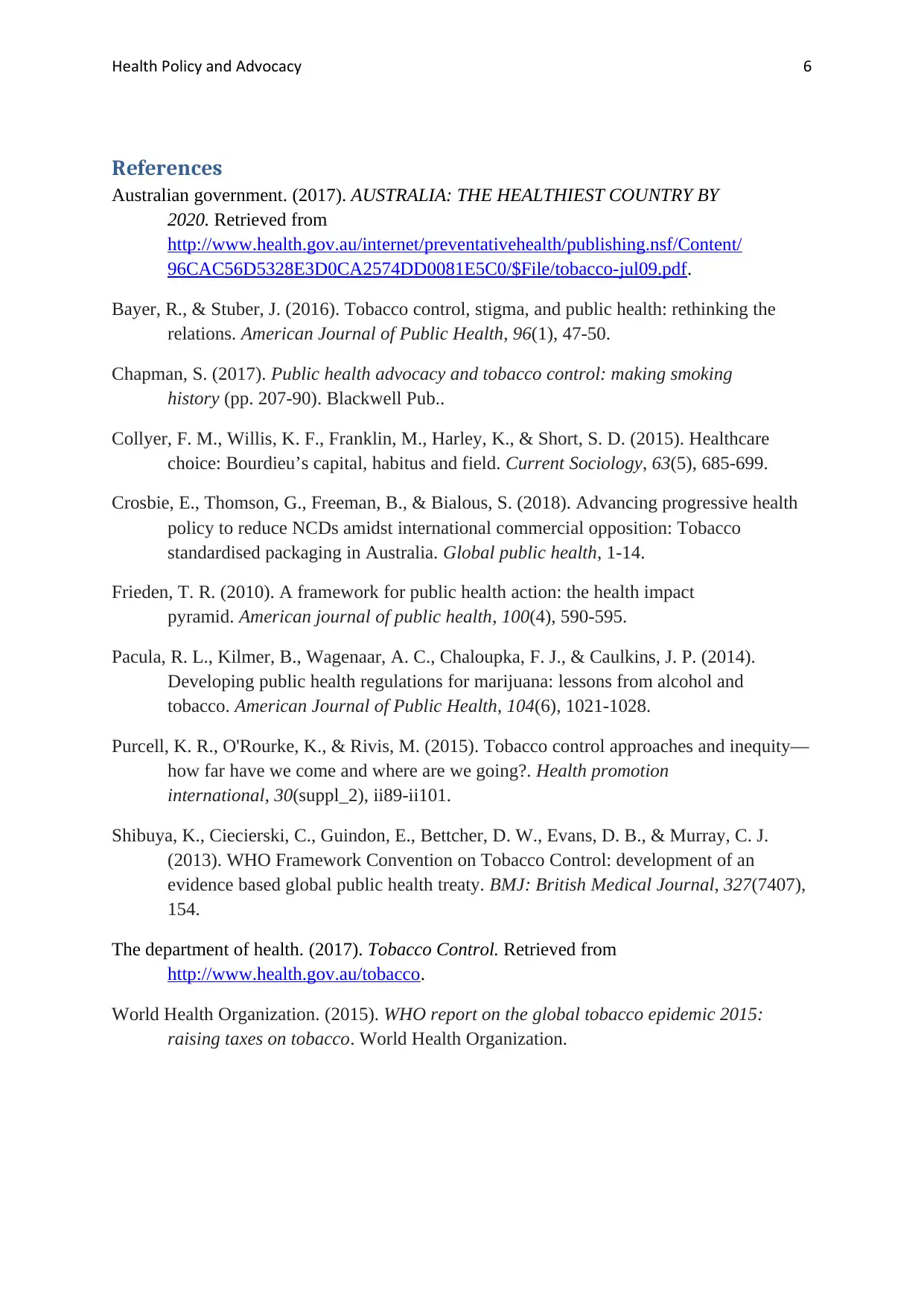
Health Policy and Advocacy 6
References
Australian government. (2017). AUSTRALIA: THE HEALTHIEST COUNTRY BY
2020. Retrieved from
http://www.health.gov.au/internet/preventativehealth/publishing.nsf/Content/
96CAC56D5328E3D0CA2574DD0081E5C0/$File/tobacco-jul09.pdf.
Bayer, R., & Stuber, J. (2016). Tobacco control, stigma, and public health: rethinking the
relations. American Journal of Public Health, 96(1), 47-50.
Chapman, S. (2017). Public health advocacy and tobacco control: making smoking
history (pp. 207-90). Blackwell Pub..
Collyer, F. M., Willis, K. F., Franklin, M., Harley, K., & Short, S. D. (2015). Healthcare
choice: Bourdieu’s capital, habitus and field. Current Sociology, 63(5), 685-699.
Crosbie, E., Thomson, G., Freeman, B., & Bialous, S. (2018). Advancing progressive health
policy to reduce NCDs amidst international commercial opposition: Tobacco
standardised packaging in Australia. Global public health, 1-14.
Frieden, T. R. (2010). A framework for public health action: the health impact
pyramid. American journal of public health, 100(4), 590-595.
Pacula, R. L., Kilmer, B., Wagenaar, A. C., Chaloupka, F. J., & Caulkins, J. P. (2014).
Developing public health regulations for marijuana: lessons from alcohol and
tobacco. American Journal of Public Health, 104(6), 1021-1028.
Purcell, K. R., O'Rourke, K., & Rivis, M. (2015). Tobacco control approaches and inequity—
how far have we come and where are we going?. Health promotion
international, 30(suppl_2), ii89-ii101.
Shibuya, K., Ciecierski, C., Guindon, E., Bettcher, D. W., Evans, D. B., & Murray, C. J.
(2013). WHO Framework Convention on Tobacco Control: development of an
evidence based global public health treaty. BMJ: British Medical Journal, 327(7407),
154.
The department of health. (2017). Tobacco Control. Retrieved from
http://www.health.gov.au/tobacco.
World Health Organization. (2015). WHO report on the global tobacco epidemic 2015:
raising taxes on tobacco. World Health Organization.
References
Australian government. (2017). AUSTRALIA: THE HEALTHIEST COUNTRY BY
2020. Retrieved from
http://www.health.gov.au/internet/preventativehealth/publishing.nsf/Content/
96CAC56D5328E3D0CA2574DD0081E5C0/$File/tobacco-jul09.pdf.
Bayer, R., & Stuber, J. (2016). Tobacco control, stigma, and public health: rethinking the
relations. American Journal of Public Health, 96(1), 47-50.
Chapman, S. (2017). Public health advocacy and tobacco control: making smoking
history (pp. 207-90). Blackwell Pub..
Collyer, F. M., Willis, K. F., Franklin, M., Harley, K., & Short, S. D. (2015). Healthcare
choice: Bourdieu’s capital, habitus and field. Current Sociology, 63(5), 685-699.
Crosbie, E., Thomson, G., Freeman, B., & Bialous, S. (2018). Advancing progressive health
policy to reduce NCDs amidst international commercial opposition: Tobacco
standardised packaging in Australia. Global public health, 1-14.
Frieden, T. R. (2010). A framework for public health action: the health impact
pyramid. American journal of public health, 100(4), 590-595.
Pacula, R. L., Kilmer, B., Wagenaar, A. C., Chaloupka, F. J., & Caulkins, J. P. (2014).
Developing public health regulations for marijuana: lessons from alcohol and
tobacco. American Journal of Public Health, 104(6), 1021-1028.
Purcell, K. R., O'Rourke, K., & Rivis, M. (2015). Tobacco control approaches and inequity—
how far have we come and where are we going?. Health promotion
international, 30(suppl_2), ii89-ii101.
Shibuya, K., Ciecierski, C., Guindon, E., Bettcher, D. W., Evans, D. B., & Murray, C. J.
(2013). WHO Framework Convention on Tobacco Control: development of an
evidence based global public health treaty. BMJ: British Medical Journal, 327(7407),
154.
The department of health. (2017). Tobacco Control. Retrieved from
http://www.health.gov.au/tobacco.
World Health Organization. (2015). WHO report on the global tobacco epidemic 2015:
raising taxes on tobacco. World Health Organization.
1 out of 7
Related Documents
Your All-in-One AI-Powered Toolkit for Academic Success.
+13062052269
info@desklib.com
Available 24*7 on WhatsApp / Email
![[object Object]](/_next/static/media/star-bottom.7253800d.svg)
Unlock your academic potential
Copyright © 2020–2025 A2Z Services. All Rights Reserved. Developed and managed by ZUCOL.





